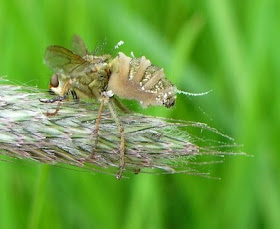---------------
Hey there Ugly Overloadians. Sadly, I won't be able to update this blog anymore. My schooling is absorbing almost 100% of my time, now. That's not unexpected with the degree I'm working toward, though.
That said, I still maintain a Tumblr blog with neat photos of entomology as well as other little critters I find fascinating. Feel free to find me there, if you are so inclined.
http://jadeneternal.tumblr.com/
Thank you to everyone that encouraged me to start contributing to this blog so long ago. I'm glad you all enjoyed my wonderful pet bugs :)
Also, to keep in theme with Ugly Overload (which is still one of my favorite blogs ever), I'll leave you with some of my newest bug photos:



The spider in these pictures was a gift from my wife. It's an adult female Avicularia versicolor (Antillies pinktoe tarantula). Versies are my favorite animal, hands down. Ironically, as sweet natured as they are, it's the only species of spider ever to bite me in my 14 years of working with bugs– and to top it off it was a baby that bit me.
When I got her, I told my better-half that I wanted a picture of her on my face. Being such a sweet spider, we didn't anticipate any difficulty with this idea. We sat down to do the photo, I put her on my face, and she quickly climbed onto the top of my head. The Mrs. snapped a quick photo before the spider jumped off and onto the floor. When I picked her up, she freaked out, locked her legs, and extended her fangs as if she was ready to bite. I calmly held my hand by her enclosure to let her walk off on her own. It was a ten minute stare down, where one slight move would have caused me to be bitten. Thanks to one of the photos taken, I got to see just how bad a spot I was in, as venom was dripping off her fangs (third photo). After around ten minutes passed, she calmly walked into her enclosure, and I stopped sweating.
After the fact, I had time to figure out what happened. I finally realized it was my shampoo. I'd just taken a shower a few minutes before we went to take the picture. Spiders taste through special receptors in their feet, which means that some chemical in my shampoo caused my little girl to freak out like none-other. Needless to say, I won't be attempting this right out of the shower ever again.
-Jaden
theeternalmusic.com














